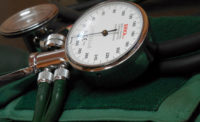Scientists working on vaccine to help lower blood pressure

A vaccine may one day help lower blood pressure for up to six months, according to new research in the American Heart Association’s (AHA) journal Hypertension.
The study in rats may eventually provide a novel alternative to treat high blood pressure in people, who would not need to take a pill every day.
Non-compliance a problem
“The potential of a vaccine for hypertension offers an innovative treatment that could be very effective for the control of non-compliance which is one of the major problems in the management of hypertensive patients,” said Hironori Nakagami M.D., Ph.D., study co-author and professor at Osaka University in Japan.
Researchers have designed a DNA vaccine that targets angiotensin II ? a hormone that raises blood pressure by causing blood vessels to constrict. This narrowing can increase your blood pressure and force your heart to work harder.
In the study, researchers immunized hypertensive rats three times at two-week intervals with needleless injections. The vaccine not only lowered blood pressure for up to six months, but also reduced tissue damage to the heart and blood vessels associated with hypertension. There were no signs of damage to other organs such as the kidney or liver.
How it works
The DNA vaccine works similar to common ACE inhibitor blood pressure medications which help blood vessels relax and open up, which, in turn, lowers blood pressure. Other types of vaccines have been tested for hypertension (e.g. a peptide vaccine), but didn’t have lasting effects and some had undesirable side effects.
The ultimate goal of an anti-hypertensive vaccine is to achieve perfect blood pressure control by improving drug compliance through the vaccine. In addition, in the developing countries like Africa and south Asia, anti-hypertensive drugs such as ARB (angiotensin receptor blockade) are expensive. A DNA vaccine may provide cheaper and effective anti-hypertensive treatments in such countries, researchers said.
“Further research on this DNA vaccine platform, including increasing the longevity of blood pressure reduction, may eventually provide a new therapeutic option to treat hypertensive patients,” Nakagami said.
The technology can also be applied to generate other vaccines.
Co-authors are Hiroshi Koriyama M.D., Ph.D; Futoshi Nakagami; M.D., Ph.D; Mariana Kiomy Osako, Ph.D; Mariko Kyutoku, Ph.D; Munehisa Shimamura M.D.; Ph.D; Hitomi Kurinami M.D., Ph.D; Tomohiro Katsuya M.D., Ph.D; Hiromi Rakugi M.D., Ph.D; and Ryuichi Morishita M.D., Ph.D. Author disclosures are on the manuscript.
Looking for a reprint of this article?
From high-res PDFs to custom plaques, order your copy today!







